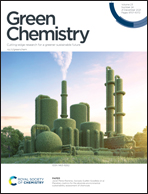Direct and oxidative dehydrogenation of propane: from catalyst design to industrial application
Abstract
The direct formation of propene from propane is a well-established commercial process, which on the basis of energy consumption, is environmentally preferred to the current large-scale sources of propene from steam cracking and fluid catalytic cracking. Propene is a major platform chemical with applications in the polymer and chemical industry and its place in modern society is guaranteed over the coming decades. At present, sources of propane are mostly non-renewable, but the development of technologies to produce renewable “green” propane are gaining traction, which coupled with new catalytic processes will provide the platform to produce green propene. In this critical review, we examine the significant advances made in the development of dehydrogenation catalysts, evaluating the technological and environmental merits. Currently, non-oxidative direct dehydrogenation (DDH) is the only commercialised process, and this is reflected in the high space–time yield commonly reported over the most active catalysts which are typically Pt or Cr based. However, the formation of coke over even the most selective catalysts necessitates multi-reactor cycling to facilitate regeneration. Oxidative dehydrogenation using O2 (ODH-O2) does not suffer from coke formation, but can lead to overoxidation, limiting the yield of propene. While no commercial processes have yet been developed, a promising new class of ODH-O2 catalysts has emerged in recent years which use boron as the active component. These catalysts are amongst the most active and selective reported to date for this reaction. The use of CO2 as a soft oxidant (ODH-CO2) has also gained interest due to the environmental advantages of utilising CO2. Although this is an attractive prospect with considerable potential, the propene yields reported over these catalysts are an order of magnitude lower than the most active DDH and ODH-O2 catalysts. Despite significant advances in the past decade, current ODH-CO2 catalysts remain far from displaying the activity levels necessary to be considered for commercial application. The specific requirements of catalyst design for each sub-reaction are discussed and we identify that, regardless of the method of dehydrogenation, the balance of acid and base sites on the catalyst surface is of paramount importance. Future catalyst design in DDH and ODH-O2 should focus on improving selectivity to propene, while ODH-CO2 catalysts are limited by their low intrinsic activity with respect to CO2. The scarcity of some common catalytic elements is also discussed, with recommendations focusing on more abundant chemical elements. Future research should focus on the low temperature activation of CO2 as a priority. With further research and development of lower energy routes to propene based on the dehydrogenation of green propane, it should be possible to transform the manufacturing landscape of this key chemical intermediate.

- This article is part of the themed collection: Green Chemistry Reviews


 Please wait while we load your content...
Please wait while we load your content...